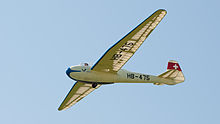Kuller
As Kuller or Kullerchen , maneuvering and transport aids for aircraft are referred to in the aviation language , originally for gliders which only had a skid and which therefore required an auxiliary landing gear for ground transport. Various types (e.g. DFS Kranich II) also had a drop-off "Kuller" which z. T. could also be used as a starting landing gear. It was not until the mid-1950s that the central gear that is common today caught on. About the gender of the term is in practical usage is no consensus: The and the Kuller were equally prevalent.
Spurkuller



In contrast to many powered aircraft , most modern gliders only have a single wheel in the fuselage as the main landing gear, which is supported at the stern by a metal grinding spur or a smaller, unguided spur wheel. Gliders are therefore difficult to maneuver on the ground, so if necessary, additional wheels or rollers that can be rotated by 360 ° are temporarily installed in order to avoid damage to the fuselage when maneuvering on the ground with narrower curve radii. To do this, the tail of the aircraft must be raised. Older models such as the Schleicher K 8 have special handles attached to the stern for this purpose, but this is no longer easily possible with newer plastic aircraft. This is why an auxiliary construction, the tail dolly , is used here : a wheel that can be rotated through 360 ° is temporarily attached to the stern. This is usually done using a padded GRP shell that grips around the fuselage and the lower part of the fin . Alternatively, the Kuller can be screwed directly onto the metal spur with a wing screw (picture on the right) or simply inserted from below into a corresponding mounting device on the vertical stabilizer (e.g. Astir ).
This makes it possible to turn the aircraft on the spot without much effort. In addition, the Kuller can serve as an attachment point for a tow bar, with the help of which the aircraft can be attached to a commercially available trailer coupling and thus moved to the take-off point by car.
hazards
If you forget to remove the Kuller before take-off, serious accidents can occur: Since the additional weight at the tail affects the center of gravity of the aircraft, changes in slow flight characteristics, including tipping and flat spin, can occur. In addition, the risk of breaking out to the side when rolling is increased. In Germany, the check of the kuller is therefore prescribed in the glider operating regulations as part of the take-off check .
Hall kuller
In order to be able to make the best possible use of the space in the hangar, which is usually limited in private aviation, the aircraft housed there are usually not simply parked next to each other, but rather nested inside one another. To do this, it is often necessary to move an aircraft diagonally or sideways to the longitudinal axis.
Gliders
In the case of gliders, the tail roll can be supplemented by a hall roll. In the simplest case, this consists of a rectangular piece of strong sheet metal , which is provided with rollers that can be rotated through 360 ° at the corners. In the middle of the sheet metal there is a recess into which the main wheel is lifted. Since weights of 400 kg can be achieved, especially with two-seater gliders, there are also a large number of tilting and lever constructions that allow the aircraft to be pushed comfortably onto the Kuller.
In contrast to spur bogies, such hall bumps are usually not supplied by the manufacturer and must therefore be made in-house or purchased separately.
Other planes
Motor-powered aircraft usually have a steerable tail or nose wheel and a smaller wingspan , which significantly improves maneuverability in the hangar compared to gliders. But here too, Kuller are occasionally used. Either each individual wheel is lifted onto its own roller or a braced metal construction is used that can accommodate the entire aircraft.
Individual evidence
- ↑ DG-Flugzeugbau: tow bar and lifting device from COBRA-Trailer , accessed on August 22, 2016
- ↑ DG-Flugzeugbau: The correct winch start , accessed on August 22, 2016
- ^ Deutscher Aeroclub eV: Glider Operating Regulations (pdf, 995 kB) as of April 2016, accessed on August 22, 2016
literature
- Matthias Gebhardt: Word formation in the language of glider pilots . GRIN Verlag, 2007, ISBN 978-3-638-71147-0 .
- Alexander Willberg : Gliding for Beginners - Theory and Practice . Motorbuch Verlag, Stuttgart 1996, ISBN 3-613-01682-6 , p. 146-147 .
Web links
- Youtube video : How a spur killer works
- Youtube video : A glider is turned in a circle by means of a tail roll.


